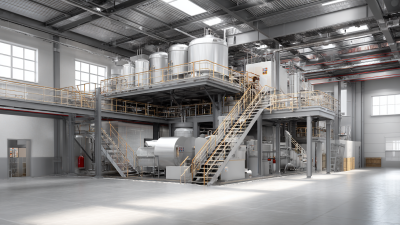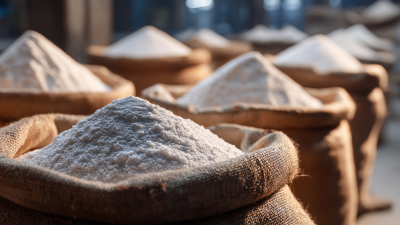How to Choose the Right Cellulose Adhesive for Your Industrial Applications
Table of Contents
- Understanding the Different Types of Cellulose Adhesives and Their Properties
- Evaluating Performance Metrics of Cellulose Adhesives in Industrial Applications
- Assessing Environmental Impact and Sustainability of Cellulose Adhesives
- Key Factors to Consider When Selecting Cellulose Adhesives for Specific Industries
- Analyzing Cost-Effectiveness of Cellulose Adhesives Compared to Synthetic Alternatives
- Unlocking Superior Adhesion: The Role of Hydroxyethylmethyl Cellulose (HEMC) in C1 & C2 Tile Adhesives
- FAQS
- Conclusion
- Related Posts
 You know, in the constantly changing world of building materials, picking the right adhesive can really make or break your project. One thing we often rely on is Cellulose Adhesive — it's super versatile and works well in all sorts of industrial settings. Here at Longou International Business (Shanghai) Co., Ltd., we totally get how important it is to choose the right adhesive for each specific job, especially since the global market is all about high-quality solutions these days. With our experience as a manufacturer of construction chemical additives and an application solutions provider, we’re able to give you customized advice on Cellulose Adhesives that not only meet industry standards but often go beyond. In this quick guide, I’ll walk you through some key factors to think about when selecting the perfect Cellulose Adhesive for your unique project, so you can expect top-notch performance and reliability every time.
You know, in the constantly changing world of building materials, picking the right adhesive can really make or break your project. One thing we often rely on is Cellulose Adhesive — it's super versatile and works well in all sorts of industrial settings. Here at Longou International Business (Shanghai) Co., Ltd., we totally get how important it is to choose the right adhesive for each specific job, especially since the global market is all about high-quality solutions these days. With our experience as a manufacturer of construction chemical additives and an application solutions provider, we’re able to give you customized advice on Cellulose Adhesives that not only meet industry standards but often go beyond. In this quick guide, I’ll walk you through some key factors to think about when selecting the perfect Cellulose Adhesive for your unique project, so you can expect top-notch performance and reliability every time.
Understanding the Different Types of Cellulose Adhesives and Their Properties
Cellulose adhesives are pretty essential in a bunch of industrial applications because they're super versatile and effective. Honestly, knowing the different types out there is kinda important if you want to pick the right one for your project. You’ve got options like carboxymethyl cellulose (CMC), hydroxypropyl cellulose (HPC), and methyl cellulose (MC). Each one has its own vibe — for example, CMC is great with water, thanks to its excellent solubility and thickening properties, so it's perfect when you need to control viscosity. On the flip side, HPC sticks better and can handle higher temperatures, which is a big plus in more demanding situations.
When you're choosing a cellulose adhesive, it’s worth paying attention to details like how strong it is, how long it takes to dry, and whether it can stand up to things like moisture or heat. Plus, the formulation can make a difference when you're working with different materials like paper, wood, or textiles. Getting a good grip on these properties helps you pick the right adhesive—one that’ll boost both the efficiency and durability of what you're working on. It’s all about finding that sweet spot for your specific needs.
How to Choose the Right Cellulose Adhesive for Your Industrial Applications
| Type of Cellulose Adhesive | Viscosity | Applications | Key Properties | Drying Time |
|---|---|---|---|---|
| Methylcellulose | Low to Medium | Ceramics, Paper, Textiles | High flexibility, Water-soluble | Fast drying |
| Carboxymethylcellulose (CMC) | Medium | Food Industry, Personal Care | Thickening agent, Non-toxic | Medium drying |
| Hydroxypropyl Methylcellulose | Medium to High | Construction, Coatings | Enhanced adhesion, Biodegradable | Slow curing |
| Ethylcellulose | Low | Pharmaceuticals, Food Coatings | Excellent moisture resistance | Very fast |
| Cellulose Acetate | Varied | Packaging, Adhesives | Good adhesive properties | Medium drying |
Evaluating Performance Metrics of Cellulose Adhesives in Industrial Applications
When you're choosing a cellulose adhesive for industrial uses, it’s pretty important to look at how well it actually performs. Things like how strong the bond is, how thick or runny the adhesive is, how fast it dries, and whether it can handle high temperatures—these all matter. For instance, adhesive strength tells you how reliably it sticks under different conditions, which is key if you want your product to last. If the adhesive has a higher viscosity, it’s usually easier to apply—especially in complex manufacturing setups—and that can make your life a lot simpler. Of course, you also want it to dry in a decent amount of time so everything moves smoothly without rushing or sacrificing the strength of the bond.
Another big deal is thermal stability—basically, how well the adhesive holds up when things heat up or cool down. Since many industrial environments expose materials to extreme temperatures, you want an adhesive that stays reliable throughout the product's life. And don’t forget about environmental factors like resistance to moisture and chemicals—these can really make or break an adhesive’s performance, especially if the product’s gonna be exposed to different conditions. By taking a close look at all these things, manufacturers can pick out the best cellulose adhesive for their specific needs, which ultimately helps improve the quality and durability of their products.

Assessing Environmental Impact and Sustainability of Cellulose Adhesives
When you're choosing cellulose adhesives for industrial use, it's really important to think about their environmental impact and sustainability. Since cellulose comes from plants, it's a renewable resource that helps cut down on our dependence on petrochemicals. Opting for cellulose-based glues can actually help industries lower their carbon footprints. Plus, these adhesives tend to be biodegradable, so they break down more easily and cause less pollution when discarded. That said, it’s also worth taking a close look at how these adhesives are made — some processes might use harmful chemicals or require a lot of energy, which isn’t ideal.

If you look at the whole lifecycle, cellulose adhesives show a lot of promise for supporting sustainability. Manufacturers should pick products that don’t just do the job well but are also made with eco-friendly practices in mind. That might mean going for adhesives that have certifications from recognized environmental programs. Doing so can help industries not only stay efficient but also do their part in protecting the environment. In the end, it’s all about making smarter choices so we can keep pushing toward a more sustainable way of manufacturing.
Key Factors to Consider When Selecting Cellulose Adhesives for Specific Industries
When you're choosing cellulose adhesives for specific industrial uses, there are a few key things to keep in mind to make sure everything works smoothly. First up, the viscosity of the adhesive is super important; it basically determines how easy it is to apply and how well it seeps into the materials you're bonding. For instance, thicker, high-viscosity adhesives tend to do better with porous materials, giving a stronger bond, while the thinner, low-viscosity ones are usually better for delicate or intricate tasks where a more precise application is needed.
Another thing to think about is how long it takes for the adhesive to dry. This can really impact your production schedule. If you're in a hurry, like in packaging or making furniture, you'd probably want something that dries quickly without sacrificing the strength of the bond. Oh, and don’t forget about the environment—temperature and humidity can totally change how the adhesive behaves, so it’s worth considering the conditions where you’ll be using it. Lastly, you’ve gotta make sure the adhesive actually works well with the materials you’re sticking together—be it wood, paper, or textiles—so the final product stays solid and durable in the long run.
Cellulose Adhesives Selection Factors in Various Industries
Analyzing Cost-Effectiveness of Cellulose Adhesives Compared to Synthetic Alternatives
When you're trying to figure out whether cellulose adhesives are cost-effective for industrial use, it's pretty important to compare how they perform and how much they cost versus synthetic options. Cellulose adhesives have some nice perks — they’re biodegradable and generally less toxic, which could mean saving money on environmental compliance down the line. Sure, they might cost a bit more upfront, but in the long run, especially for industries aiming to be more eco-friendly, they often save money overall. Sometimes, it’s like planting a seed for future savings.
**A few tips to pick the right adhesive:**
- Think about the environmental impact. Going with cellulose might help cut costs related to regulations and waste management.
- Look at what your project needs. Cellulose adhesives tend to hold up well in different conditions, so you might not need a bunch of different types.
- Don’t just focus on the purchase price — consider the total cost of ownership. That includes disposal and potential health impacts, which really rounds out the full picture.
If companies take a good hard look at all these points, they can make smarter decisions that fit both their budget and their commitment to sustainability.
Unlocking Superior Adhesion: The Role of Hydroxyethylmethyl Cellulose (HEMC) in C1 & C2 Tile Adhesives
Hydroxyethylmethyl Cellulose (HEMC) plays a crucial role in enhancing the adhesion properties of C1 and C2 tile adhesives. Specifically, Modcell® T5035 is a highly effective, non-ionic, water-soluble polymer powder developed by the Longou R&D team to elevate the performance of tile adhesives. This advanced cellulose ether is particularly designed for C2 high-end tile adhesives, offering superior working abilities that meet stringent industry standards.
The use of HEMC, like Modcell® T5035, has transformed the landscape of construction chemicals over the past 15 years. Longou Company, a leading manufacturer in the production of HPMC, HEMC, and redispersible polymer powders, has enabled countless customers worldwide to overcome challenges in dry-mix mortars. With a focus on innovation and quality, their products contribute to cost savings and improved efficiency in tile adhesive applications, reinforcing their global reputation in the construction sector.
FAQS
: The common types of cellulose adhesives include carboxymethyl cellulose (CMC), hydroxypropyl cellulose (HPC), and methyl cellulose (MC), each offering unique properties suited for various applications.
CMC is known for its excellent water solubility and thickening ability, making it ideal for applications that require viscosity control.
HPC provides improved adhesion and higher thermal stability, which is beneficial for high-performance applications.
Viscosity affects how easily the adhesive can be applied and its ability to penetrate the materials being bonded; high-viscosity adhesives may be better for porous materials, while low-viscosity options are suited for thinner substrates.
The drying time is critical as it can affect production timelines; industries needing fast assembly, like packaging or furniture manufacturing, benefit from adhesives that dry quickly without sacrificing bond strength.
Temperature and humidity conditions are essential to consider, as cellulose adhesives can behave differently under varying climate conditions, affecting their performance.
The compatibility of the adhesive with materials like wood, paper, or textiles is vital for ensuring effective adhesion and durability in the final product.
Conclusion
Hey, I came across this article called 'How to Choose the Right Cellulose Adhesive for Your Industrial Applications,' and it covers some pretty crucial points about cellulose adhesives. Honestly, getting to know the different types and their unique properties is super important—especially for industries that depend on these materials. You also really need to look at how these adhesives perform to make sure they actually fit the specific needs of your project. And let’s not forget about the environment! Today, everyone’s really into eco-friendly stuff, so considering the environmental impact and sustainability of cellulose adhesives is a big deal.
When you're picking out a cellulose adhesive, things to think about include what your industry actually needs and whether it’s cost-effective compared to synthetic options. Here’s the thing—Longou International Business (Shanghai) Co., Ltd., which works in construction chemicals, stresses how vital it is to understand these factors. They aim to provide adhesives that aren’t just effective but also eco-friendly and efficient, helping meet global construction demands without messing up the planet.
Related Posts
-

Challenges Faced with Using Customized Re-Dispersible Latex Powder
-

7 Essential Tips for Understanding Hydroxyethyl Cellulose Solubility in Water
-

Understanding the Functionality of Polycarboxylate Superplasticizer in Modern Construction
-

How to Choose the Right Cellulose Ether Factory for Your Business Needs
-

Understanding Hpmc Use in Modern Manufacturing Processes
-

Crafting Excellence with Chinese Manufacturing Powered by Best Thickening Agent Hpmc for Detergent






